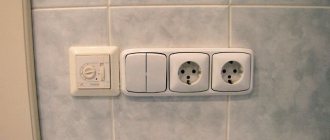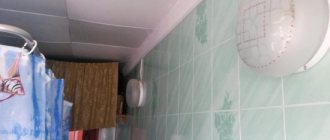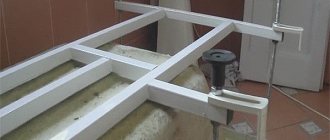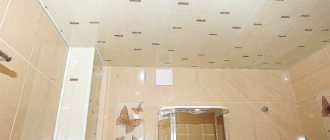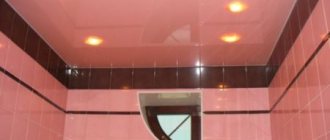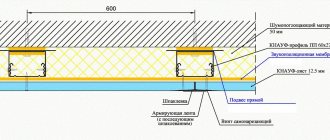Application benefits
The popularity of such cladding is explained by many advantages:
- low cost. The panels are much cheaper than tiles, the installation of which, moreover, requires a major renovation of the room;
- simple and quick installation. You can make the cladding yourself without having any special skills;
- cleanliness of the installation, the material does not contain a lot of dust and debris;
- a large assortment;
- the material is resistant to mold and mildew;
- do not require special care, easy to wash and clean;
- durability;
- resistant to moisture;
- are made from safe and environmentally friendly materials.
Flaws:
- not resistant to mechanical damage;
- when ignited, toxic substances are released;
- If installed incorrectly they are dangerous.
There are more advantages than disadvantages. With the right selection and installation, they will decorate the bathroom for a long time.
Main advantages of use
The installation process will not require any special professional skills from you, which can be completed without the help of expensive specialists. It is worth noting the financial component of consumables, which will cost you an order of magnitude lower than when installing tiles.
Plastic panels perform well when used in a humid environment. Even with long periods of use they will retain their original appearance.
Washing machine under the sink in the bathroom - interesting ideas and secrets on how to install a washing machine
With proper installation, with their help, it is possible to hide all visual unevenness of the wall, such as pits, waviness or swelling. Among other things, it is possible to hide water communications.
Having a lot of advantages, they are inferior to tile coverings in terms of service life. Another difference is that the tiles are made from natural materials, which means they are more environmentally friendly. There are many options for finishing a bathroom with plastic panels.
Options for choosing PVC panels
When choosing, follow some recommendations:
- 1) Choose smooth panels and focus on the quality of the material. Curves and uneven ones will soon have to be replaced and all repairs will ultimately be more expensive.
- 2) Select sheets in the same color tone, preferably the same number and from the same batch.
PVC panels are easily bent and rolled into a tube, which is very convenient for transportation. At home, they need to be turned around within a day so that they straighten, take the desired shape and get used to the temperature in which they will constantly be.
Panels or tiles
The preference for one type of finish over another is associated with certain features of their use.
Advantages of such panels:
- simple, quick installation;
- easy care;
- easy repair;
- efficiency;
- original design.
Advantages of this type of tile:
- better moisture resistance;
- high strength.
Acrylic and aquapanel have good moisture resistance and durability, so tiles are increasingly being ignored when decorating a room.
Methods for installing wall and ceiling plastic panels
There are mainly two methods used for installation:
- 1) Frame - cladding with sheathing.
- 2) Frameless - glued without framing the frame.
The most profitable and convenient method is frameless. For the first method of fastening, it is necessary to make a special metal frame, which takes up additional space. In addition, in the resulting void between the wall and the frame, a favorable atmosphere arises for the emergence of microorganisms. But the adhesive method is suitable for perfectly flat surfaces.
Cladding with lathing
When working with this method, it is initially necessary to install the sheathing. It is made from:
- wooden blocks. Before installation, it is best to treat them with an antiseptic and anti-mold solution. The material is attached to the frame using wood screws, nails with a wide head, or staples from a construction stapler;
- metal profile. Galvanized metal is better suited for a bathtub. Fastened with metal screws.
The frame slats are installed perpendicular to the location of the panels.
Having installed the frame, fasten the panels tightly to each other so that there are no gaps. It is best to start from the far corner from the front door. For a socket or switch, the required hole in the material is cut out in advance and then secured.
To give a complete and aesthetic look, upon completion of the installation of the sheets, floor and ceiling skirting boards are attached.
On glue without frame sheathing
With this method, the material is attached to the surface using glue. It should be borne in mind that the method is only suitable for a perfectly flat surface.
The glue is applied in a zigzag motion, and the panels are attached to the surface, tightly adjacent to each other. At the end of the work you need to install skirting boards (ceiling and floor).
Installation methods
Glue mount
Fastening to a frame
Installation of plastic panels in the bathroom can be done in two different ways. Firstly, they can be glued directly to the wall, and secondly, they can be attached to a pre-prepared frame.
In the first case, you will first have to carefully prepare the wall surface in order to ensure the tightest possible fit of the panel sheets. If the wall surface has significant unevenness, then preference is given to the second option. The disadvantage of this method is the reduction in usable area, but it makes it possible to improve heat and noise insulation and hide all communications.
DIY installation of plastic panels in the bathroom
One of the main advantages of PVC panels is the ability to install them yourself, without any special skills. How to organize work correctly?
What do you need
Required tools:
- 1) Drill with drills for installing dowels, and a wood bit to drill holes for sockets.
- 2) Screwdriver, screwdriver, construction stapler, glue - depending on the method of fastening.
- 3) A saw with a metal blade to cut panels.
- 4) Construction level.
- 5) Knife to cut to width.
- 6) Floor and ceiling skirting boards.
- 7) Cladding panels.
Where to start installation: finishing the ceilings or walls
Initially, it is necessary to prepare the surface: remove the old finish, it is better to fill large recesses, and trim off any protruding ones.
Next, treat with a primer and antibacterial compound to prevent the appearance of fungus and mold. Then they begin to install the sheathing, if the method is frame.
Marking walls and ceilings
The marking stage cannot be skipped, because this guarantees correct fastening of the material. The entire surface must be marked with markers, making beacons every 40 - 50 centimeters.
How to mount on the ceiling
Initially, it is necessary to install a metal supporting profile around the perimeter using self-tapping screws, onto which the panels will be attached. If the bathroom area is more than 4 square meters, then suspended profiles are installed across the load-bearing structure at a distance of 50 centimeters.
Next, the starting profile or ceiling plinth is installed. The first panel is inserted into the profile, the next ones are attached using self-tapping screws. This way all elements are installed.
It is better to combine the installation of lamps with the installation of panels.
What is the best way to mount it on walls?
The working technique is the same as on the ceiling: a profile is installed and a panel is inserted into it and secured with self-tapping screws.
If you attach it with glue or liquid nails, then the product is applied in zigzag lines to the middle of the finishing material. This is necessary so that when pressed it does not leak out of the front side. Press tightly against the wall for 5-7 minutes. The last panel usually has to be adjusted to size by cutting.
How to sheathe faster
To level the surface, you can use the technology of plasterboard structures. This will reduce the work time and volume.
If the surface is too uneven, then it is easier to use the frame method with sheathing.
How to choose the right one
There are several important rules that will help you buy PVC panels for the bathroom:
For high strength of the material, it is necessary to select panels with a large number of jumpers. The more stiffening ribs, the less possibility of the panel breaking. And be sure to check each individual part for defects.
Pay attention to the appearance and design features of the material. On high-quality products, the decorative coating is applied with high precision and without flaws.
Try to connect the two parts; there should be no gaps between them in the locking system.
If the tile does not correspond to the size stated on it, you should think about whether to buy this product. It is possible that all products will not be of adequate quality and other difficulties may be encountered during the installation process.
Basic recommendations
- For a small bathroom, it is appropriate to choose light shades, thus increasing the visual volume of the room;
- An interesting solution is the arrangement of plastic panels of different sizes and designs. For example, you can combine contrasting tones;
- The wooden texture will allow you to decorate the room in an ethno style;
- You should not combine polyvinyl chloride cladding with expensive materials, such as marble. In this case, the interior will turn out tasteless;
- If desired, you can choose plastic panels for tiles. Thus, the decoration of the bathroom can be done in a classic or neoclassical version - with columns, friezes and borders;
- Photo printing allows you to create an individual design, thanks to modern paint application technologies;
- Sheathed walls go well with slatted ceilings.
Dimensions
If the room has a non-standard height or layout, you need to pay special attention to these parameters. The length of the panels is usually 2.5–3 m. If you need to cover only the upper or lower part of the wall with them, you can select the elements so that a minimum of waste is left when cutting. The thickness of the products is usually 5–12 mm, and the width ranges from 100 to 500 mm. For a bathroom, it is better to choose the widest ones: the fewer joints, the less likely it is that moisture will accumulate in the seams. But if the room is small or has a non-standard shape, in order to save money, it is more advisable to choose narrow stripes. Calculating their number is simple: the length of each wall must be divided by the width of the selected panel. It is better to consider the element to be cut as a whole, without planning to use the remaining part elsewhere.
Walls
52 votes
+
Vote for!
—
Vote against!
The use of decorative plastic panels is an excellent alternative to modern finishing materials, be it tiles or marble. Their use in interior design has become a very relevant solution today. Decorative panels can be used to cover ceilings and walls. They are moisture resistant, so they are best suited for rooms where there is a high level of humidity: bathrooms, showers, swimming pools.
Advantages of wall panels
Plastic is the only material that will not deteriorate if exposed to direct water. All other wall panels are more or less resistant to moisture, so when choosing a material for finishing a bathroom, you need to take this into account. The success of PVC wall panels for the bathroom lies in the cost-effectiveness and speed of working with this material. Let's look at the other advantages of plastic panels:
- The panels are joined to each other without much effort, without requiring preliminary surface preparation.
- The panel has many transverse partitions, and this guarantees good strength of the final coating.
- PVC wall panels for bathrooms are able to hide any unevenness, while giving the surface the desired decor.
- Channel voids in panels are great for hiding electrical wiring.
- Such panels are coated with a specialized varnish, which further protects them from mechanical damage and ultraviolet radiation.
- Each plastic panel consists of insulated cells, which gives the material soundproofing properties.
- Plastic panels have good thermal insulation properties, and are also non-flammable and self-extinguishing.
- In addition to moisture resistance, wall panels can easily withstand significant temperature changes, which is also important for bathrooms.
- They do not retain dirt and dust, and any dirt can be easily removed with a damp cloth.
- The color collection of wall panels includes hundreds of colors.
- The low price of wall panels for the bathroom is also an advantage, which, along with the high quality of the products, allows the wall panels to gain a firm foothold in the Russian building materials market.
- When fastening the panels, they are mounted closely, which gives the room integrity and completeness of the decor.
- The only drawback is the slightly reduced usable surface, which is made up of wall slats and panels. But you can choose slats as thin as possible. In addition, you can choose panels of the smallest thickness.
Choosing the right material
To choose wall panels for installation in the bathroom, you first need to understand their classification and existing color scheme. Slat panels are similar in appearance to lining and come in the following types of fastening systems: tongue-and-groove, tongue-and-groove and tongue-and-groove. The dimensions of the slatted panels vary within the following limits: length 0.9 - 3 meters, width 13.5-30 centimeters, thickness 8 - 12 millimeters. If you install such panels in a horizontal direction, you can make the walls visually wider. Installing wall panels vertically will create the feeling of taller walls.
Sheet wall panels for the bathroom are similar in appearance to plywood; their front part imitates valuable types of wood, leather and natural stone. The most common overall dimensions are as follows: thickness 3 - 6 millimeters, size 1.22 by 2.44 meters. Due to the large size of the sheets, installation of plastic panels of this type is carried out quite quickly. Finishing with plastic panels is done using jointing or sealing the seams.
The tile panels are made in the shape of a square; the size range generally ranges from 30 by 30 to 90 by 90 centimeters. Finishing with tiled panels allows you to recreate a unique mosaic.
The color of the wall panels should be in harmony with the surrounding interior. Therefore, it is best to choose light-colored panels for the bathroom, in particular if the room is small in size. The fact is that gloss can visually increase space, make it wider and larger. The most suitable shades will be the following: light pink, peach, blue, golden yellow, soft blue.
It is better to choose panels of medium width, although installation with wide panels will be faster, but it is more difficult to adjust in problem areas, and more waste is left. Narrow panels are easy to fit, but the process will take longer. When purchasing, check the bathroom wall panel for dents, chips, holes and unpainted areas on the front side. The surface of the product over its entire width should be smooth and without waves. And finally, try connecting two panels in the store; the joint along the entire length should be neat and unnoticeable.
Preparatory work
Installation of PVC panels in a bathroom can be done by an ordinary person who does not have special skills. To do this, you will need very ordinary tools that are found in every home - a hammer, a screwdriver and a drill. First, prepare the material that you will use to decorate the bathroom.
To create the sheathing, take wooden planks that are impregnated with a waterproof compound, or special plastic planks that are sold in the same retail outlets where PVC wall panels are sold. Before installation, it is required that the wall panels lie for about forty minutes at room temperature. Make sure their joints are dry and clean.
Creating a wooden sheathing
If the walls in the bathroom are perfectly smooth, and all the corners do not require modification and are even, then the installation of wall panels in the bathroom can be carried out directly on the concrete base of the walls using special glue. But this is not always advisable, because the walls of the bathroom in most cases have various defects, which is why it is necessary to make lathing from wood, on which you will attach PVC panels.
First, take measurements of the surface and calculate the dimensions of the vertical beams that make up the wooden frame. The sheathing is made of wooden beams, which have a cross-section of 10 by 30 millimeters or from a metal profile.
Before installing the pepper slats, it is necessary to mark the wall using a building level to avoid unevenness and distortions. If the walls are uneven, place small pieces of wood under the lath to achieve a perfectly even result. The crossbars must be placed at a distance of 30 centimeters from each other, while the lowest crossbar must be in contact with the floor, and the topmost bar must border the edge of the panel.
Attach the sheathing to the wall using self-tapping screws or nails; when choosing a metal profile for fastening, you need to use self-tapping screws. After installing the sheathing, install the fittings and guides that are necessary to hide the corner joints of the panels. Cover the joint with the floor with a PVC plinth; if desired, choose a model with a wiring box.
To fasten the guides, it is recommended to use nails, self-tapping screws and mounting clips. If the fastening is done on a metal profile sheathing, you only need to use self-tapping screws.
Installation of wall panels
Before final fastening of the PVC panels, you need to once again use a plumb line to check how level the panel is relative to the vertical. Finishing the bathroom with plastic panels begins from the corner of the room. The whole procedure comes down to cutting the panels to the required height level and installing them in the guides.
It is best to start attaching wall panels from the door. Fasten the first panel with the joint facing outwards and towards the next ones with the groove. This technology is the most convenient. The panels are fastened with self-tapping screws or self-tapping screws. You can also use a construction stapler, so the staples will be almost invisible. After fixing one panel, you need to install the next one. Interestingly, thanks to the locking fastenings, there is no need to adjust the panels.
When installing wall panels, you will gradually approach the corner of the opposite wall. The last panel, as a rule, does not fit in size and needs to be trimmed. To do this, cut the panel using a utility knife and a metal ruler or corner. The panel is cut very easily, and it will not be difficult to cut it, the main thing is to correctly measure the part that will go to waste.
When you approach a corner, measure the top and bottom distances from the corners to the nearest panel. On the panel that will fit in this place, also make 2 marks on the bottom and top. Draw a line between the marks using a ruler or straight edge, and cut the panel along this line.
For cutting, you can also use a hacksaw with a tooth pitch of 1 millimeter. When cutting plastic wall panels for the bathroom, try to keep the protective film until the end. Then the presentation will be preserved, and the appearance of the finish in the bathroom will always be at a high level of your professionalism.
The bathroom has such peculiar features as the presence of water pipes, sewers and other obstacles that need to be circumvented. To do this, attach the panel to the problem area and use a marker to outline the approximate location of the cut. You should never overline because you may cut out too much material. It is better to apply the panel several times and cut off one millimeter at a time. Only then will the panel fit into place without gaps and beautifully.
The decoration of a bathroom often requires maximum sealing of the walls, and therefore it is recommended to treat the joints between wall panels with silicone sealant, evenly distributing it over the entire internal surface of the joint. Sealing will help protect the walls from excessive moisture and fungus.
Final stage
After finishing the bathroom with wall panels, you can begin the final work. They consist of decorating the doorway and corners. Special plastic ebbs and corners are intended for such purposes. The sills must be installed in the opening.
The junction of the panels and the ebb is hidden with a decorative corner, which is pre-coated with waterproof glue and after 15-20 minutes is placed in place. Don't press the corner too hard, it's made of plastic after all. The same corners can be used to smooth out the joints of panels in the corners of the room.
Another touch lies in the following - to process the “wall-ceiling” and “wall-floor” joints, it is customary to use plinth strips. The plinth can be made of plastic or wood with varnish impregnation. Polystyrene skirting boards are also suitable. The transition between the wall and the floor is not recommended to be made with polystyrene, because there is a high risk of damage.
They snap into place with simple movements into the resulting gaps between the frame or panel. If you didn’t keep an eye on the level when installing the wall panels, the baseboard will pop out in some places.
Useful tips
When installing plastic wall panels in the bathroom, you need to remember some things that should not be done:
- You cannot remove the protective film, if any, from the wall panels in the bathroom in advance.
- It is not recommended to strongly wrinkle or bend the panels, because they will get a very unattractive appearance.
- When fixing wall panels, it is not recommended to use a hammer and nails. One miss and the plastic panel will be damaged.
- It is not advisable to make marks on the panels with a sharp object, because if you put a mark by mistake, you will not be able to remove it. You should mark with a carpenter's pencil or a special marker, because they can be relatively easily removed with a damp cloth.
- PVC panels can be sawed with a regular wood hacksaw, but this can only be done with a tool with a tooth pitch of no more than one millimeter. If you take a hacksaw with a large pitch, you can tear the edges of the panels.
- Do not cut the panels from the back side. They need to be cut only from the front decorative side, as shown in the photo of wall panels for the bathroom. In this case, the cut will not show any burrs on the installed product.
- When cleaning wallboards, it is not recommended to use chemicals that are not listed in the manual instructions. Otherwise, stains may appear on the product that cannot be washed off.
As you understand, when working with plastic panels you don’t need any special skills, but you need to choose the material wisely, strictly follow the instructions for installing wall panels in the bathroom and remember our recommendations.



